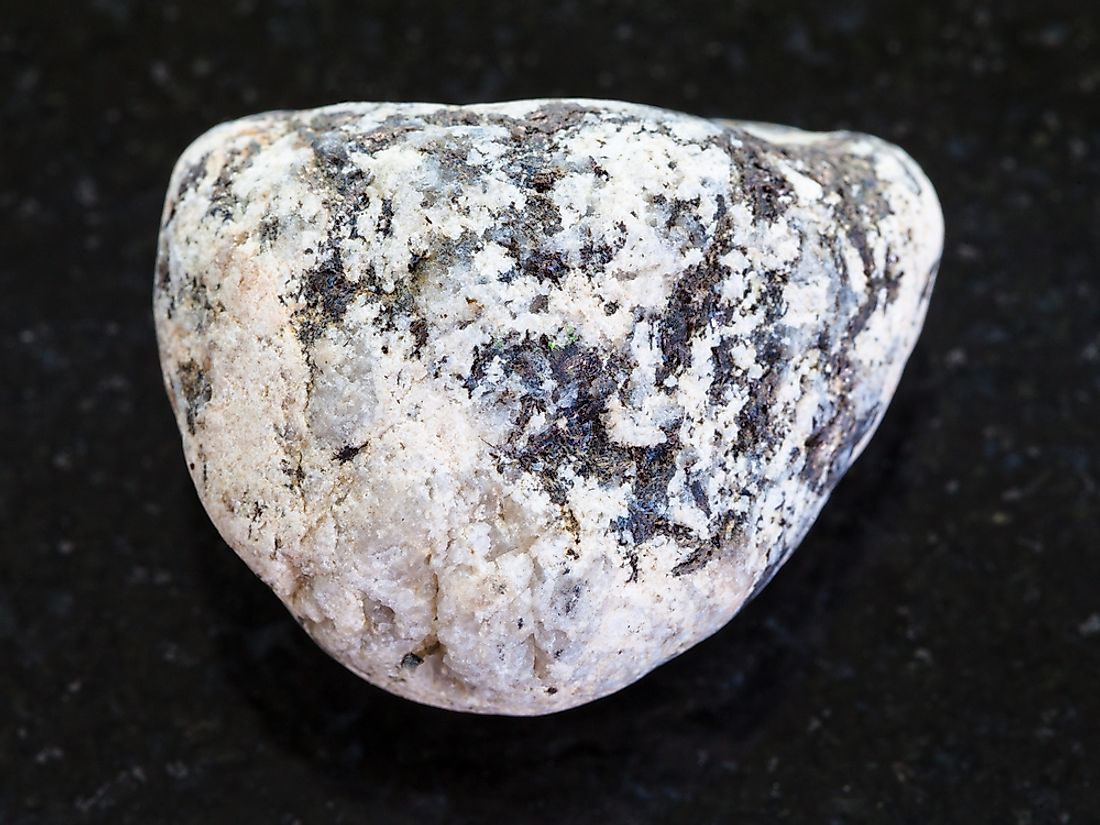What is Diorite?

5. Description
An igneous rock formed by subterranean crystallized magma, Diorite is composed of plagioclase feldspar, quartz, hornblende, pyroxene and biotite. Varieties that lack hornblende are referred to as "leucodiorite". The color of diorite varies from grey to dark grey to black, speckled with lighter colors that may appear white. Diorite might contain small amounts of apatite, ilmenite, microcline, and other minerals. It is rated as 7 on the Moh’s hardness scale (about the same as quartz), and possesses a speckled, or "phaneritic", appearance due to the presence of a mixture of minerals in its composition. It has a coarse, grainy structure, wherein its large grains are arranged in an interlinked pattern. The density of this rock is between 2.36 and 2.53 grams per cubic centimeter, and its specific gravity is between 2.8 and 3.0 times greater than that of water. It is easily recognized by geologists by virtue of its unique texture, and its "salt and pepper" appearance in terms of coloration.
4. Location
Diorite deposits are relatively rare, and most commonly occur as sills, dikes, or stocks, or in the form of large masses as batholiths, and are often associated with coinciding with gabbro and granite deposits. Deposits of this rock are found in scattered areas all over the world. Namely, deposits occur in certain localities of such countries as the United Kingdom (Aberdeenshire and Leicestershire), Germany (Saxony and Thuringia), Romania, Italy (Sondrio, Guernsey), New Zealand (Coromandel peninsula, Stewart Island, Fiordland), Turkey, Finland, central Sweden, Egypt, Chile, and Peru, as well as the U.S. states of Nevada, Utah and Minnesota. In Corsica, a Mediterranean island belonging to France, an orbicular (spheroidical) variety of diorite is found which is referred to as "Corsite" or "Napoleonite", in homage to its place of origin and the French leader, respectively.
3. Formation
Partial melting of oceanic plates results in the production of basaltic magma. As this magma rises up, it reaches the granitic rock of the continental plate. As the basaltic magma melts the granite bed it produces granitic magma, and such a mixture of magma has a composition of both granite and basalt. If this magma cools and crystallizes before it reaches the surface of the earth, it results in the formation of diorite deposits. Diorite formations usually take place in volcanic arc regions above subducting plates, or as batholiths during cordilleran mountain building.
2. Uses
Diorite’s durability is comparable to that of granite, and hence it is often used as a base material in the construction of roads and buildings. It is also used to control soil erosion by being utilized as a drainage stone. The dimension stone industry also uses diorite to create such sculpted rock products as ashlars, pavers, and facing stones. Ancient civilizations, including the Inca and Maya of the New World, used this stone as a structural stone in building their marvelous architectural wonders. Many cobblestone streets in England, Scotland, and other places around the world were constructed using diorite. The St. Paul’s Cathedral, in London, has steps made of Diorite. Even though this stone was used by sculptors of the Middle East in ancient times, its hardness makes it difficult to use for sculpting, and hence it is not favored as a sculpting stone by artists of our present day and age. The Code of Hammurabi, one of the first sets of codified laws, was carved into one of the most famous diorite sculptures. The code's tablet is designed as a 7-foot-tall, black pillar with inscriptions of these early Babylonian laws. Occasionally, Diorite has been used as a gemstone, especially as cabochons.
1. Production
Unlike many other minerals, there is little data related to the diorite mining and processing industries available to the public. Diorite, being a relatively rare mineral, is only commercially mined in small pockets of areas where its deposits occur, such as the United Kingdom and some other European countries, New Zealand, and a few sub-Saharan African, South American, and North American countries. Diorite was also mined in the ancient world, as is evident by the extensive use of this rock in ancient architecture.











